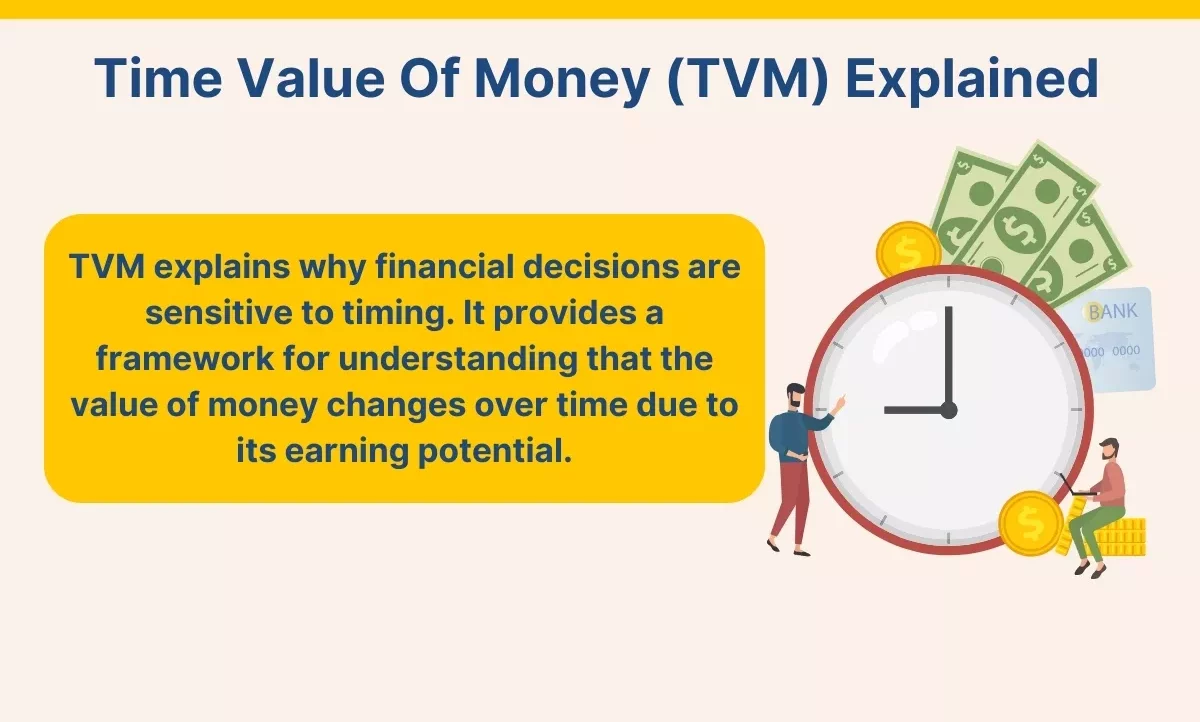The Use of Time Value & Money in Corporate Finance: TVM Explained
Table of Contents

There is a famous slang phrase, “time is money”? But there is an insightful concept that shows the value of money in a period of time. The concept is the time value of money (Tvm). However, it does not mean that time is money but signifies a meaning and is a helpful resource in the company’s finance.
Let’s dive further and look at what TVM means and how to use the time value of money concept in corporate finance. Also, it is crucial for professionals who are pursuing executive business management programs (EBMP) or for learners interested in investment to know the time value money concept to set a strong base for their business fundamentals.
What is TVM in Finance?
The time value of money (TVM) concept is that the money you have with you today is worth more than the exact amount you would receive in the future. It is because of the profit that can be earned during the interim.
It is highly recommended in small businesses for better profit. Also, understanding the TVM can help you make decisions like which job provides a better salary, what type of investment you should consider, and what will be the good rate for the loan. Hence, it shows potential growth and brings more value.

*UnStop
How Does the Time Value of Money Work?
In corporate finance, the time value money concept is a very essential concept because of the money invested and its growth over time. In fact, the money can still earn compound interest even if it is in a savings account. It helps to focus on identifying the real value of cash flow.
Moreover, it signifies the expected future due to the business or individual investment decisions made from time to time. For instance, the money deposited into a savings account earns interest. Over time, the interest is added to the principal, which leads to making more interest. And that’s the power of compound interest.
How to Calculate the Time Value of Money
Here is the formula to calculate the time value money concept:
Future value= Present Value × [1 + (i / n)] (n x t)
FV = the future value of money
PV = the present value
i = the interest rate or other return that can be earned on the money
t = the number of years to take into consideration
n = the number of compounding periods of interest per year
Let’s take an example by using this formula. A person has invested $20,000 for one year at 10% interest compounded annually. The future value of the money-
Future value = $20,000 × [1 + (i / 10)] (1 x t).
$22,000
Time Value of Money in Corporate Finance
Hence, companies consider the time value of money to make decisions about investing in new product development, acquiring new business equipment, or establishing credit terms for the sale of their product.

*Investopedia
Calculating TVM is necessary, as it helps financial sectors make effective investment decisions. By using this concept, the key investors compare the available investment options and determine the best options to invest in. However, due to the expected loss in the value of money, the rate of interest and tenure of repayment for loan and mortgage schemes are intended. Moreover, choosing the time value of money also helps revise the wages of workers and the costs of consumer goods.
Institutes like IMT Ghaziabad offers courses on EBMP to upscale the time value of money and give you practical knowledge on how to use the time value of money in corporate finance.
Applications of TVM in Corporate Decision-Making
- Capital Budgeting: NPV and IRR for Project Evaluation
- The time value of money concept helps companies evaluate long-term investment projects through Net Present Value (NPV) and Internal Rate of Return (IRR).
- TVM in finance ensures that future cash inflows are discounted to their present value for better decision-making.
- By understanding TVM, businesses can choose projects that maximize profits and shareholder value.
- NPV and IRR analysis helps prioritize investments and reduce financial risk by comparing expected returns over time.
- Investment Analysis: Evaluating ROI for Long-Term Projects
- The time value of money concept is key for assessing potential returns on long-term corporate investments.
- It lets businesses calculate the present value of future income streams using TVM in finance.
- Understanding TVM helps make realistic comparisons between different investment options.
- This approach allows investors and managers to spot opportunities that promote sustainable growth and maximize return on investment (ROI).
- Loan and Debt Management: Determining EMIs and Interest Costs
- Companies use the time value of money concept to accurately calculate loan repayments, EMIs, and interest obligations.
- TVM in finance enables organizations to compare financing options and analyze long-term borrowing costs.
- By understanding TVM, businesses can manage debt more efficiently and improve liquidity.
- This ensures steady cash flow, reduces interest expenses, and supports healthy financial management.
- Business Valuation: Discounted Cash Flow (DCF) Models
- The time value of money concept is the basis for the Discounted Cash Flow (DCF) method in valuation.
- Using TVM in finance, analysts discount future cash flows to estimate the present value of a business.
- Understanding TVM helps determine fair market value for mergers, acquisitions, or equity investments.
- DCF analysis gives a realistic view of a company’s worth based on future earning potential and risk factors.
- Lease vs. Buy Decisions: Evaluating Future Cash Obligations
- Businesses use the time value of money concept to choose between leasing or buying assets.
- By applying TVM in finance, they discount future lease payments and compare them with upfront purchase costs.
- Understanding TVM helps evaluate which option offers better financial efficiency and long-term savings.
- This analysis ensures optimal capital use, cost control, and asset management for strategic financial planning.
- Dividend Policy Decisions: Retaining or Distributing Earnings
- The time value of money concept assists firms in deciding whether to pay dividends or reinvest profits.
- Using TVM in finance, management compares the present value of immediate payouts with potential future gains.
- Understanding TVM enables companies to balance shareholder expectations with long-term growth.
- This leads to effective use of profits, stable growth, and strengthened investor confidence in corporate decisions.
Conclusion
The Time Value of Money (TVM) is one of the most important financial principles guiding corporate decision-making. It helps organizations evaluate investments, manage debts, and improve long-term financial strategies. Understanding the concept of time value of money lets businesses assess the value of future cash flows and make informed economic choices. Applying TVM in finance ensures better resource allocation and sustainable growth. By understanding what TVM is and using modern analytical tools, companies can increase profitability, reduce risks, and create a strong foundation for effective financial management and corporate success.
Frequently Asked Questions
What is the time value of money in finance?
Time value of money in finance describes that an amount of money now is more valuable than the same amount later because of its potential to earn money. This time value money principle assists investors and companies with making wiser financial choices.
What are the 4 types of time value of money?
The four forms of time value of money include present value, future value, annuities, and perpetuities. Professionals use these to apply TVM in finance to assess investments and long-term yields.
What's the difference between NPV and TVM?
TVM in finance is a basic premise measuring how the value of money fluctuates over time, and NPV uses that as a method to analyze investment profitability. The time value money premise serves as the foundation for proper NPV calculations.
What are the 4 types of TVM problems?
The most common types of TVM problems include determining present value, future value, interest rate, or time. Knowledge of what is TVM allows financial analysts to solve these problems for savings, investments, and loans efficiently.
Recent Blogs
It seems we can't find what you're looking for.














